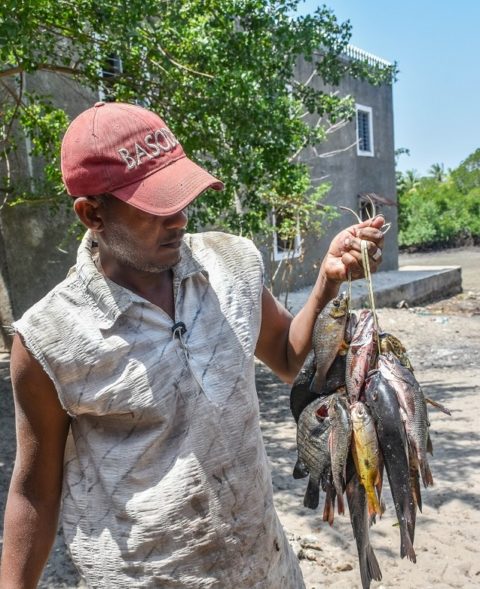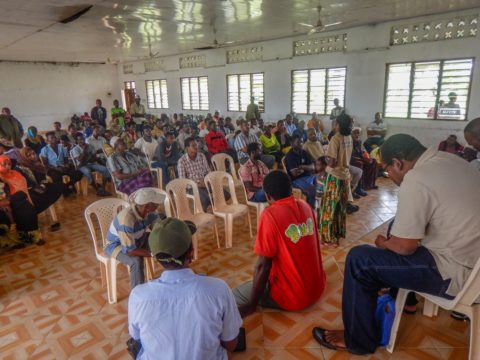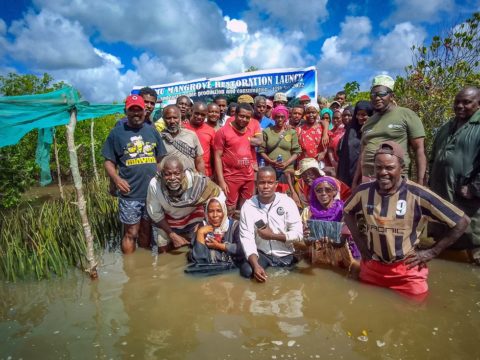Mangroves, with their distinct, entangled root systems, were largely overlooked and misunderstood in the past decades. According to Dan Friess, they were suspected to produce miasma or noxious air and as a reservoir for diseases such as malaria, both of which were proven false with time. Today, these mystical coastal forests are considered super solutions despite some unflattering myths still lingering to date.

Ali Ahmed with his catch of the day at Matondoni, Lamu
For the Lamu community along Kenya’s coastal strip bordering Somalia, mangroves are life for they depend on them for fish, house construction materials, wood fuel, traditional medicine and therapy, and a buffer against storms, erosion and floods, among other services. Mangroves are also incredible carbon sinks as they store up to five times more carbon than terrestrial forests. Their role in reducing the negative impacts of climate change cannot be gainsaid.
However, most mangrove ecosystems in the Western Indian Ocean region such as in Lamu have been on the decline in the past decades. According to the National Mangrove Ecosystem Management Plan (2017-2027), Lamu hosts 37,350 hectares of mangroves, which represents 61 per cent extent in Kenya. The degraded area stands at 14,407 hectares. This is due to natural changes caused by the 1997-98 El Niño phenomenon and increased human activities.
Recent events in Lamu resulting from climate change such as erratic rainfall patterns, disappearance of some species and decreasing fisheries are a major concern for stakeholders including the community. One notable cause of all this is increased resource extraction necessitated by the ballooning human population. Some benefits associated with mangroves have equally declined, with resident communities adapting to diminishing resources to sustain their livelihoods.
To ensure sustainable long-term use of these rich ecosystems, various stakeholders – local and international – have developed initiatives to mitigate the further loss of mangrove forests and to restore degraded areas to their original status or closest possible through the assisted natural regeneration process. The raft of measures to stem further loss of mangrove forests; source alternative livelihood ventures for the mangrove-dependent communities, and restore degraded areas. In line with this new drive and working with the Kenya Forest Service (KFS), we have embarked on an elaborate plan to restore mangroves in some of the most degraded areas in Lamu.
To set a solid foundation, in collaboration with Mangrove Action Project, we trained community members from representative groups in the County on the CBEMR technique. We have continually advocated for this successful approach which supports natural regeneration first and then active planting only where necessary. Lamu has relatively well-established community-based organisations that have a growing interest in mangrove restoration. What has been lacking, however, is inadequate access to training opportunities and exposure to successful techniques in ecosystem restoration such as the CBEMR. Following the inaugural CBEMR training last March, six goodwill community champions were identified and equipped with the necessary skills to advocate for the approach among the communities.

With the successful launch of a collaborative mangrove planting campaign by KFS working with the communities and other stakeholders, we embarked on restoration efforts in Kiboyani area of Mkunumbi, a sleepy village west of Lamu Town, about 340 kilometres from Kenya’s coastal hub Mombasa. With support from the goodwill champions, a brief outreach and awareness meeting was held in Mkunumbi centre. Women, who were the majority at the meeting, were encouraged to take the lead in mobilising other community members to protect mangroves as extensive loss affects women and children more than men.
Fatuma Bwana Mzee, one of the champions and the chairlady of Tarazak Women Group in Matondoni Village urged women to be active in their groups, citing some socio-cultural, economic and physico-chemical factors as major deterrents to mangrove restoration success. “In the past, Lamu women’s interaction with mangroves was very limited due to our culture and role in society. But now we are, albeit still at some low level. With support from organisations such as Wetlands International, we are involved in initiatives that foster both the conservation of mangrove resources and sustainable livelihood options which in turn reduce the pressure on our coastal forests,” said Fatuma.

Mkunumbi has numerous pockets of degraded mangroves, some of which are ideal for natural regeneration and others for active planting
As the leader of Pate Resources and Tourism Initiative, a 23-member community group that works with the youth in Pate Island, Mohammed Kassim’s message focused on sustainable livelihoods and income generation for community groups. “I urge you to take any available opportunities in mangrove conservation to create jobs and generate an income. But that demands honest hard work in order to attract more donor funding through local and international NGOs.”
As a reminder of the integral role of this mangrove ecosystem, Abdulrahman Lali, chairman of Lamu Community Forest Association (CFA) delved into the cost of establishing CFAs where he appealed to well-wishers to assist communities in developing strategies to manage existing CFAs or establishing new ones where necessary. “CFAs are good and legally recognised. However, they are resource intensive and require qualified personnel. Training and capacity building are integral for CFA members,” said Lali.

The community was also taught how to establish and nurture a mangrove nursery (submerged on left)
The Mkunumbi community was thereafter taught practically about the substantive aspects of the CBEMR technique. Six days later, some 45,073 mangroves seedlings and propagules of Rhizophora mucronata and Bruguiera gymnorhiza had been actively planted in degraded pockets in the area. A mangrove tree nursery of Rhizhophora mucronata was also established.
Wetlands International is committed to integrating mangroves conservation efforts which entails promoting livelihood through alternative sustainable ventures, restoring degraded areas and ensuring sustainable use of the trees where necessary.


Leave a comment